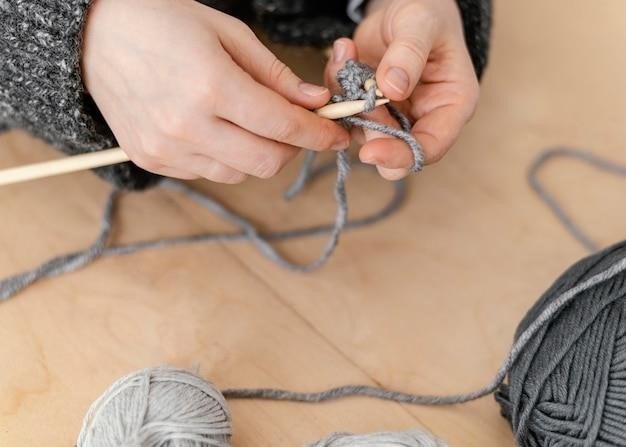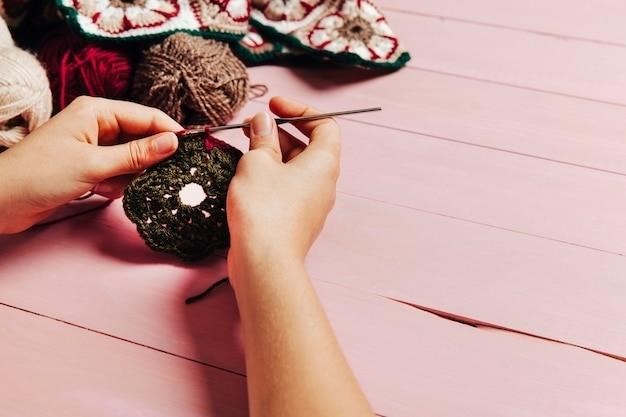Choosing the Right Resources
The internet is a treasure trove of resources for beginner crocheters. YouTube channels like “Simplydaisy” and “The Crochet Crowd” offer step-by-step video tutorials that break down the basics of crochet. Pinterest boards dedicated to crochet provide inspiration and a visual library of patterns and projects.
YouTube Channels for Beginners
YouTube is a fantastic resource for learning how to crochet‚ offering a wealth of beginner-friendly tutorials. Channels like “Simplydaisy” cater specifically to absolute beginners‚ providing clear and concise explanations of basic stitches and techniques. The “Crochet Crowd” is another great option‚ offering a comprehensive crash course on crochet fundamentals. These channels are designed to guide you through the initial stages of learning‚ ensuring you develop a solid foundation in crochet basics.
Pinterest Boards for Inspiration
Pinterest is a visual goldmine for crochet inspiration. Its vast collection of boards dedicated to crochet offers a world of ideas for beginner projects. Explore boards featuring simple scarves‚ blankets‚ and amigurumi toys to spark your creativity. You can find patterns‚ stitch tutorials‚ and even step-by-step photo guides to help you bring your chosen projects to life. Pinterest is an excellent tool for discovering new patterns‚ techniques‚ and color combinations‚ providing a constant stream of inspiration for your crochet journey.

Learning the Basics
Mastering the fundamental stitches and techniques is crucial for any beginner crocheter.
Essential Crochet Stitches
The foundation of crochet lies in mastering a few essential stitches. The chain stitch‚ a series of interconnected loops‚ forms the base of many projects. The single crochet stitch‚ created by inserting the hook into a loop and pulling through two loops‚ creates a dense fabric. The slip stitch‚ a simple stitch used to join rows or close off projects‚ is often used to create a neat finish.
Understanding these fundamental stitches unlocks a world of possibilities‚ allowing you to create a variety of basic projects and progress to more intricate designs.
How to Hold Your Hook and Yarn
The way you hold your crochet hook and yarn significantly impacts your tension and the overall look of your work. The most common grip for beginners is the “pencil grip‚” where the hook is held like a pencil‚ with the yarn held between your thumb and forefinger. This grip allows for good control and is comfortable for many crocheters.
Experiment with different positions for your yarn‚ such as wrapping it around your pinky finger or holding it in your palm. You can also try different types of hooks‚ such as ergonomic hooks‚ to find what suits your hand best.
Remember‚ there is no right or wrong way‚ and the best method is the one that feels most comfortable and allows you to maintain consistent tension.
Creating a Slip Knot
The slip knot is the foundation of every crochet project. It’s the first loop you create on your hook‚ and it serves as the starting point for your chain. To make a slip knot‚ you’ll need to create a loop with your yarn and then secure it with your hook.
There are many different ways to create a slip knot‚ but one of the easiest methods is to form a loop with the yarn‚ wrap the yarn around the loop‚ and then pull the tail of the yarn through the loop.
Once you’ve created the slip knot‚ you’ll be ready to start your first chain‚ which is a series of connected loops that forms the basis of your crochet project.
Chain Stitch
The chain stitch is the most basic stitch in crochet and the foundation for building more complex stitches and patterns. It’s a simple loop made by wrapping the yarn around the hook and pulling it through the loop on the hook.
You’ll start by creating a slip knot on your hook. Then‚ you’ll wrap the yarn around the hook and pull it through the loop to create the first chain stitch. To continue the chain‚ you’ll repeat this process‚ wrapping the yarn around the hook and pulling it through the loop on the hook‚ creating a new loop each time.
The chain stitch is essential for beginning crocheters because it is used to create the foundation rows of many projects‚ and it’s a crucial step in learning the other basic stitches.
Single Crochet
The single crochet stitch is another fundamental stitch in crochet. It’s a simple stitch that creates a tight‚ dense fabric. This stitch is often used for creating sturdy items like blankets‚ bags‚ and amigurumi.
To make a single crochet stitch‚ you’ll insert your hook into the next stitch on your chain or row‚ wrap the yarn around the hook‚ and pull it through both loops on the hook. This creates a new stitch‚ and you’ll continue to repeat this process to create a row of single crochet stitches.
YouTube channels like “ExpressionFiberArts” and “The Crochet Crowd” offer excellent tutorials on how to master the single crochet stitch. They provide clear instructions and close-up visuals to help beginners understand this essential technique.
Moving Beyond the Basics
Once you’ve mastered the essential stitches‚ you can explore more advanced techniques. These include double crochet and half double crochet‚ which add texture and dimension to your projects.
Double Crochet
The double crochet stitch (dc) creates a taller stitch than the single crochet‚ adding texture and dimension to your work. Mastering the double crochet is a crucial step in your crochet journey‚ opening up a world of possibilities. To create a double crochet‚ you’ll need to yarn over (YO)‚ insert your hook into the next stitch‚ YO again‚ pull the loop through‚ and finally YO and pull through both loops on your hook. It’s a bit more involved than the single crochet‚ but with practice‚ it becomes second nature.
Many YouTube channels offer detailed tutorials on how to execute the double crochet stitch correctly. These videos often include close-up shots and clear explanations‚ making it easier for beginners to grasp the technique. You can find tutorials tailored to both right-handed and left-handed crocheters‚ ensuring everyone can learn at their own pace.
Half Double Crochet
The half double crochet (hdc) stitch is a versatile stitch that falls somewhere between the single crochet and the double crochet in height. It creates a slightly denser fabric than the double crochet‚ while still offering a bit more texture than the single crochet. Learning the half double crochet expands your crochet vocabulary and allows you to create a wider range of patterns and designs.
To execute a half double crochet‚ you’ll need to YO‚ insert your hook into the next stitch‚ YO again‚ pull a loop through‚ and finally YO and pull through both loops on your hook. It’s a bit more involved than the single crochet but less complicated than the double crochet‚ making it a great intermediate stitch to master. You can find numerous tutorials on YouTube that break down the half double crochet step-by-step‚ ensuring you understand every aspect of this essential stitch.
Understanding Crochet Patterns
Crochet patterns are the blueprints for your projects‚ guiding you through each stitch and row to create your desired design. At first glance‚ they can seem daunting‚ but with a little practice‚ you’ll become comfortable reading and interpreting them.
Crochet patterns use abbreviations to represent different stitches‚ such as “sc” for single crochet‚ “dc” for double crochet‚ and “hdc” for half double crochet. They also include instructions on how many stitches to make in each row and how to turn your work. Online resources‚ like YouTube channels and Pinterest boards‚ offer visual guides that break down the intricacies of crochet patterns. Many pattern designers also include video tutorials along with their written patterns‚ making the process even easier to follow.
Don’t be afraid to experiment and practice. The more patterns you work with‚ the more confident you’ll become in your ability to decipher them and bring your crochet creations to life.

Tips for Success
As you embark on your crochet journey‚ consistent practice and a few key tips will ensure a smooth and enjoyable experience.
Choosing the Right Yarn
Yarn selection is crucial for a beginner crocheter‚ as it significantly impacts the ease of working with it and the final appearance of your projects. When starting out‚ it’s recommended to opt for cotton or acrylic yarns‚ known for their user-friendliness. These yarns are readily available‚ affordable‚ and come in a wide array of colors‚ allowing you to experiment and find your favorites. Cotton yarns are known for their durability and breathability‚ making them ideal for items like dishcloths‚ blankets‚ and clothing‚ while acrylic yarns are typically softer and less prone to shrinking‚ making them a good choice for projects like scarves‚ hats‚ and amigurumi toys. Additionally‚ the weight of the yarn‚ often represented by a number‚ influences the thickness of the yarn and the size of the crochet hook you’ll need. For beginners‚ a medium weight yarn (weight 4) is a good starting point as it’s easy to work with and produces projects of a manageable size. When selecting yarn‚ pay attention to the recommended hook size indicated on the label‚ as using the right size hook ensures consistent tension and a pleasing stitch definition. Remember‚ choosing the right yarn is a personal preference‚ so experiment and discover what works best for you and your projects.
Selecting the Correct Hook Size
The size of your crochet hook is equally important as the yarn you choose‚ as it directly impacts the tightness of your stitches and the overall look of your work. While the yarn label will typically suggest a recommended hook size‚ it’s always good to experiment and find what works best for you. A general rule of thumb is to use a hook size that creates a comfortable tension for your chosen yarn‚ allowing you to work without feeling strained. If your stitches are too loose‚ your project may become flimsy and unravel easily. Conversely‚ overly tight stitches can make your work appear dense and create a stiff fabric. To determine the correct hook size‚ it’s helpful to create a gauge swatch‚ a small sample of stitches using your chosen yarn and hook. This allows you to see how the stitches look and adjust the hook size accordingly if needed. By experimenting and finding the right balance between hook size and yarn weight‚ you can achieve consistent stitches and create beautiful‚ durable crochet projects. Remember‚ practice makes perfect‚ so don’t be afraid to experiment and explore different hook sizes until you find the perfect fit for your style and preference.
Maintaining Consistent Tension
One of the most crucial aspects of successful crocheting is maintaining consistent tension. Consistent tension refers to the tightness or looseness of your stitches‚ and it significantly impacts the appearance and durability of your work. When your tension is consistent‚ your stitches will be uniform in size and shape‚ resulting in a smooth‚ even fabric. If you vary your tension throughout a project‚ your stitches may become uneven‚ causing bumps and gaps in your fabric. This can make your work look uneven and create a less polished finish. Several factors can affect tension‚ including your grip on the hook‚ the yarn you are using‚ and your overall crocheting style. Practice and patience are key to achieving consistent tension. To maintain consistent tension‚ try to keep your hook at a comfortable angle and apply a gentle‚ steady pressure while pulling the yarn through the loop. It’s helpful to practice crocheting with the same yarn and hook size‚ gradually increasing the complexity of your projects as you gain experience. By focusing on consistency and paying attention to the feel of your stitches‚ you can develop a rhythm and technique that will help you achieve consistent tension and create beautiful‚ well-crafted crochet projects.
Troubleshooting Common Problems
As you embark on your crochet journey‚ you might encounter a few common problems. Don’t worry‚ these are normal hurdles that most crocheters face. One common problem is dropped stitches. This happens when the yarn slips off your hook before you’ve secured it properly. To prevent dropped stitches‚ make sure you are holding your yarn securely and pulling it through the loop with a firm‚ controlled motion. Another issue is uneven tension‚ which can result in a bumpy or uneven fabric. Pay attention to the tightness of your stitches and try to maintain a consistent tension throughout your project. If you are struggling with tension‚ experiment with different hook sizes to find one that feels comfortable and produces the desired stitch size. You may also encounter problems with counting stitches or following patterns. Take your time‚ carefully count your stitches‚ and refer to your pattern frequently. If you get lost‚ don’t hesitate to start over or seek help from online resources or a more experienced crocheter. Remember‚ practice makes perfect‚ and every stitch you make brings you closer to mastering this beautiful craft.
Project Ideas for Beginners
Once you’ve mastered the basics‚ you can start exploring fun and rewarding projects. Beginners can tackle simple scarves‚ blankets‚ and amigurumi toys.



